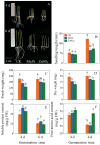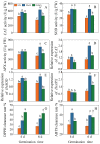Methyl Jasmonate and Zinc Sulfate Induce Secondary Metabolism and Phenolic Acid Biosynthesis in Barley Seedlings
- PMID: 38891320
- PMCID: PMC11174577
- DOI: 10.3390/plants13111512
Methyl Jasmonate and Zinc Sulfate Induce Secondary Metabolism and Phenolic Acid Biosynthesis in Barley Seedlings
Abstract
This study aimed to reveal the impact of MeJA and ZnSO4 treatments on the physiological metabolism of barley seedlings and the content of phenolic acid. The results showed that MeJA (100 μM) and ZnSO4 (4 mM) treatments effectively increased the phenolic acid content by increasing the activities of phenylalanine ammonia-lyase and cinnamate-4-hydroxylase (PAL) and cinnamic acid 4-hydroxylase (C4H) and by up-regulating the expression of genes involved in phenolic acid synthesis. As a result of the MeJA or ZnSO4 treatment, the phenolic acid content increased by 35.3% and 30.9% at four days and by 33.8% and 34.5% at six days, respectively, compared to the control. Furthermore, MeJA and ZnSO4 treatments significantly increased the malondialdehyde content, causing cell membrane damage and decreasing the fresh weight and seedling length. Barley seedlings responded to MeJA- and ZnSO4-induced stress by increasing the activities of antioxidant enzymes and controlling their gene expression levels. Meanwhile, MeJA and ZnSO4 treatments significantly upregulated calcium-adenosine triphosphate, calmodulin-dependent protein kinase-related kinase, and calmodulin-dependent protein genes in barley seedlings. This suggested that Ca2+ may be the signaling molecule that promotes phenolic acid synthesis under MeJA and ZnSO4 treatment. This study deepens the understanding of the phenolic acid enrichment process in barley seedlings under MeJA and ZnSO4 treatments.
Keywords: barley seedlings; methyl jasmonate; phenolic acid; zinc sulfate.
Conflict of interest statement
The authors declare no conflicts of interest.
Figures






Similar articles
-
Melatonin mediates phenolic acids accumulation in barley sprouts under MeJA stress.Front Nutr. 2024 Jun 4;11:1403293. doi: 10.3389/fnut.2024.1403293. eCollection 2024. Front Nutr. 2024. PMID: 38899320 Free PMC article.
-
Effect of Methyl Jasmonate on Phenolic Accumulation in Wounded Broccoli.Molecules. 2019 Sep 30;24(19):3537. doi: 10.3390/molecules24193537. Molecules. 2019. PMID: 31574924 Free PMC article.
-
Exogenous methyl jasmonate combined with Ca2+ promote resveratrol biosynthesis and stabilize sprout growth for the production of resveratrol-rich peanut sprouts.Plant Physiol Biochem. 2023 Oct;203:107988. doi: 10.1016/j.plaphy.2023.107988. Epub 2023 Aug 28. Plant Physiol Biochem. 2023. PMID: 37672960
-
Effects of methyl jasmonate and NaCl treatments on the resveratrol accumulation and defensive responses in germinated peanut (Arachis hypogaea L.).Plant Physiol Biochem. 2023 Jan;194:664-673. doi: 10.1016/j.plaphy.2022.12.012. Epub 2022 Dec 16. Plant Physiol Biochem. 2023. PMID: 36563572
-
The role of signaling compounds in enhancing rice allelochemicals for sustainable agriculture: an overview.Planta. 2023 Sep 29;258(5):90. doi: 10.1007/s00425-023-04241-w. Planta. 2023. PMID: 37775539 Review.
References
-
- Tyagi A., Shabbir U., Chen X., Chelliah R., Elahi F., Ham H.J., Oh D.H. Phytochemical profiling and cellular antioxidant efficacy of different rice varieties in colorectal adenocarcinoma cells exposed to oxidative stress. PLoS ONE. 2022;17:e0269403. doi: 10.1371/journal.pone.0269403. - DOI - PMC - PubMed
LinkOut - more resources
Full Text Sources
Research Materials
Miscellaneous

